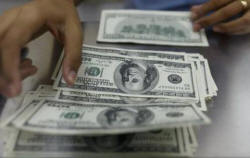|
The
Australian and New Zealand dollars both lost about 1
percent. The dollar index was up 0.3 percent at 97.876, after
rising as high as 98.334 on Friday, its strongest since April
23, after data showed U.S. nonfarm payrolls rose 215,000 last
month.
That fell short of expectations for a rise of 223,000 jobs but
was still viewed as consistent with a strong labor market, and
the previous two months were upwardly revised.
The dollar hit a two-month high of 125.07 yen on Friday,
and was last up 0.5 percent at 124.75, buoyed by elevated
two-year U.S. Treasury yields. The euro was down 0.3 percent at
$1.0930.
"The jobs data was supportive for a September rate hike," said
Jeremy Stretch, head of currency strategy at CIBC World Markets.
"U.S. yields are modestly higher, but dollar/yen needs more
widening of the interest rate spread to take it higher. Right
now, there isn't much of a conviction so it will be a slow grind
higher for the dollar."
Speculators increased bullish dollar bets to their highest since
early June, according to Reuters calculations and data from the
Commodity Futures Trading Commission released on Friday. The
value of the dollar's net long position climbed to $32.77
billion in the week ended Aug. 4, from $29.79 billion the
previous week.
Meanwhile, the Australian dollar fell 0.8 percent to trade at
$0.7359, hurt by a drop in commodities and oil and by the
biggest drop in Chinese exports in four months in July, 8.3
percent compared with a forecast 1 percent fall.
"The Aussie is the most exposed G10 currency to trade with
China. Iron ore imports fell 29 percent in the year to July,
highlighting that once the second-round effects of lower
commodity prices kick into weaker data in Australia, there is
likely to be another leg lower in the currency," Morgan Stanley
said in a note to clients.
(Editing by Tom Heneghan/Ruth Pitchford)
[© 2015 Thomson Reuters. All rights
reserved.] Copyright 2015 Reuters. All rights reserved. This material may not be published,
broadcast, rewritten or redistributed. |
|





